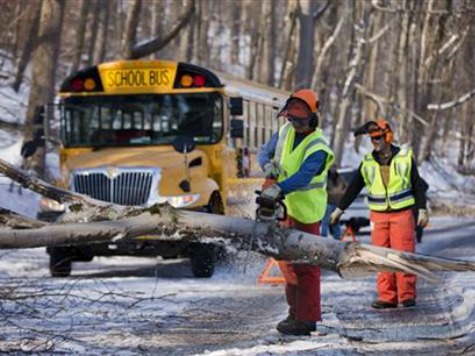South Eastern America is seeing its earliest and deepest snow falls in over 100 years, whilst temperature records have also been broken. The cold spell is drawing predictions of a new mini ice age between at least 2015 and 2035, or possibly for the rest of this century. Tennessee, North and South Carolina and Georgia all saw unexpected snow, in some places up to a foot deep.
The Climatology Office in South Carolina has confirmed that Concord, South Carolina has broken a 125 year record for the earliest snow seen. The office also said that South Carolina has already doubled its annual expected snowfall, over a month and a half before any snow is expected.
State legislatures are having to find extra cash as road salting and clearance budgets have ballooned. Maryland has been forced to nearly double its budget this year from $70m to $130m, whilst the biggest rise in percentage terms is in Arkansas, where legislators are digging deep to find an extra $16.5m, up from just $1.5m last year. Other states have already blown through their budgets are having to consider where to make cuts to fill the gap. Virginia is facing a $150m shortfall already, and that figure may yet rise.
Tennessee, Arkansas, Kentucky and up into West Virginia are expected to have 167 percent of their average snowfall this winter, according to WeatherBell, whilst much of the surrounding South Easer States is the snowfall this year is expected to be up a third on the average level.
The phenomenon is blamed on a solar vortex, forcing cold temperatures down the eastern seaboard and into the South East of the country. Similar effects are being seen in Russia, parts of China and across central Asia including Kazakhstan, Kyrgystan, Uzbekistan and down into Afghanistan. Most of Europe, conversely, is seeing markedly higher temperatures, as is Alaska.
The cooling was predicted at least two years ago by Russian scientist Habibullo Abdussamatov, supervisor of the Astrometria project on the International Space Station and head of space research at the Pulkovo Observatory, St Petersburg. Abdussamatov has predicted that this year will mark the start of a downward trend into a mini ice age, with its nadir in 2055. The cold period would be the fifth mini ice-age to occur in a millennium, suggesting that the climate is following a well-worn natural pattern.
In a video posted on climate science website Watts Up With That, David DuByne, editor of Oilseed Crops said “Active region count of sun spots is going to decrease over the next couple of solar cycles, which will usher in a period of cold weather as well as the Pacific seems to be cooling down. it’s almost a perfect storm that we’re going into a cool phase. The Atlantic will soon follow around 2020, and once all three of these indicators turn cool the planet’s definitely going to follow into a cool phase.
“We are going to have to start incorporating food growing areas into our cityscapes, termed ‘edible cities’. Cities are a little bit warmer than the countryside, there’s a lot of ambient heat. We’re going to have to harness that and use it to our benefit.”

COMMENTS
Please let us know if you're having issues with commenting.